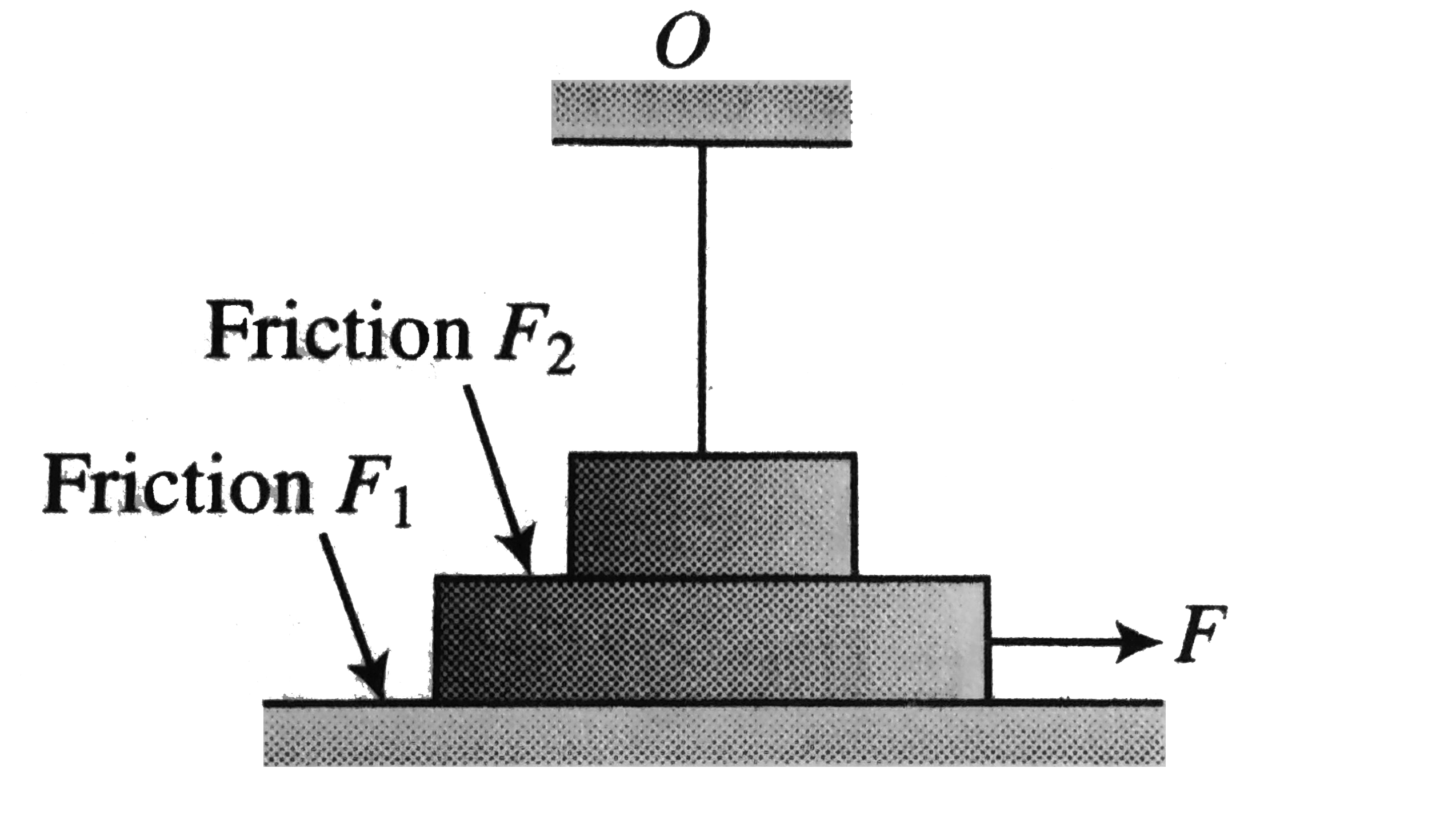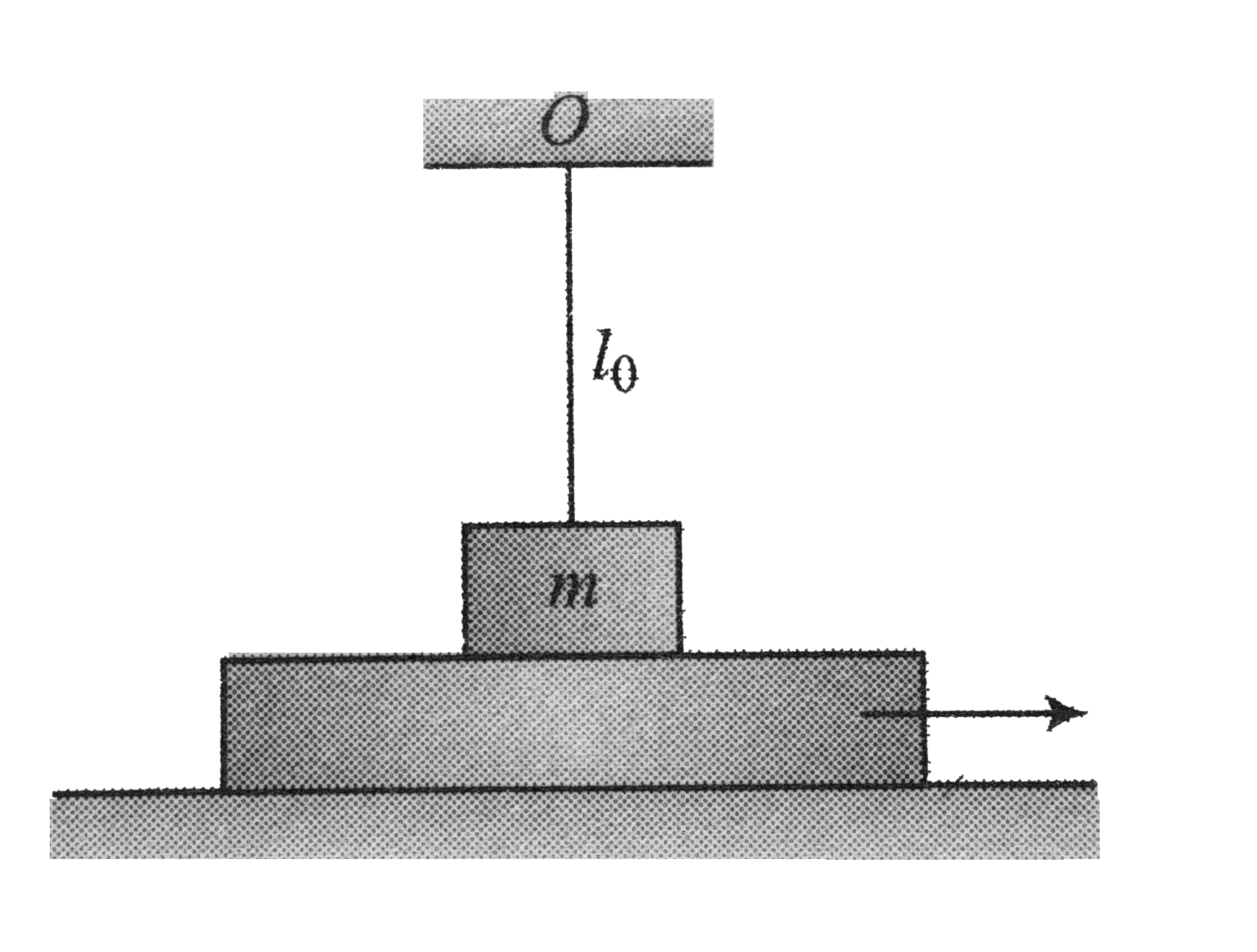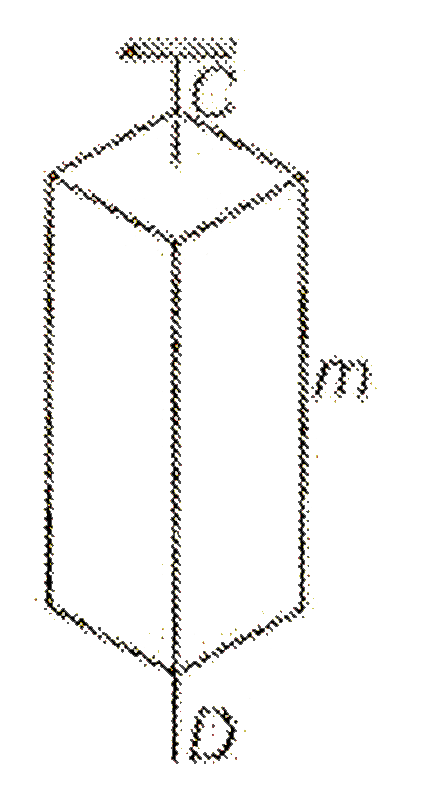A horizontal plane supports a plank with a block placed on it. A light elastic string is attached to the block, which is attached to a fixed point O. Initially, the cord is unstretched and vertical. The plank is slowly shifted to right until the block starts sliding over it. It occurs at the moment when the cord deviates from vertical by an angle θ=0∘. Work done by the force F equals

(a) Energy lost against friction F1 plus strain energy in cord
(b) Work done against total friction acting on the plank alone
(c) Work done against total friction acting on the plank plus strain energy in the cord
(d) Work done against total friction acting on the plank plus strain energy in the cord minus work done by friction acting on the block
The correct Answer is:A, B, D
When the plank is shifted, the cord elongates and becomes inclined with vertical. Therefore, a tenstion is developed in the cord and that tension has two components, a vertical component and a horizontal component: Horizontal component tries to slide the block leftwards, relative to the plank. But friction F2 prevents that slipping. Hence, the block moves to the right with the plank.
Since the block does not slip over the plank, no energy is lost against friction F2. Hence, work done by the force F is used to overcome loss against friction F1 and to elongate the cord. Therefore, option (a) is correct.
The cord elongates due to displacement of the block and the block gets displaced due to friction F2 acting on it. Hence, the friction F2 is responsible for the elongation of the cord. Therefore, strain energy stored in the cord is equal to work done by the friction on the block or work done against friction acting on the upper surface of the plank. Hence, the total work done by F is equal to energy lost against friction F1 plus work done against friction acting on upper surface of the plank. Therefore, option (b) is correct. Hence, it is obvious that option (c) is wrong.
Since, strain energy stored in the cord is equal to work done by friction acting on the block, option (d) becomes same as option (b). Hence, it is also correct.
Topper's Solved these Questions
- BOOK - CENGAGE PHYSICS ENGLISHCHAPTER - WORK, POWER & ENERGYEXERCISE - Linked Comprehension55videos
WORK, POWER & ENERGY
- BOOK - CENGAGE PHYSICS ENGLISHCHAPTER - WORK, POWER & ENERGYEXERCISE - Integer14videos
WORK, POWER & ENERGY
- BOOK - CENGAGE PHYSICS ENGLISHCHAPTER - WORK, POWER & ENERGYEXERCISE - Single Correct100videos
WORK, POWER & ENERGY
- BOOK - CENGAGE PHYSICS ENGLISHCHAPTER - VECTORSEXERCISE - Exercise Multiple Correct5videos
VECTORS
Similar Questions
A horizontal plane supports a plank with a bar of mass m placed on it and attached by a light elastic non-deformed cord of length l0, to a point O. The coefficient of friciton between the bar and the plank is equal to m. The plank is slowly shifted to the right until the bar starts sliding over it. It occurs at the moment when the cord derivates from the vertical by an angle θ.

Find the work that has been performed by the moment by the frictional force acting on the bar in the reference frame fixed to the plane.View SolutionAsseration : A plank A is placed on a rough surface over which a block B is placed. In the shown situation, elastic cord is unstretched. Now a gradually increasing force F is appled slowly on A until the relative motion between the block and plank starts.
 .
.
At this moment cord is making an angleθ with the vertical. Work done by force F is equal to energy lost against fricton f2, plus potential energy stored in the cord.
Reason : work done by static friction f1 on the system as a whole is zero.View SolutionA plank with a uniform sphere placed on it rests on a smooth horizontal plane. The plank is pulled to the right by a constant force F. It the sphere does not slip over the plank, then
 View Solution
View SolutionA horizontal plank has a rectangular block placed on it. The plank starts oscillating vertically and simple harmonically with an amplitude of 40 cm. The block just loses contact with the plank when the latter is at momentary rest Then.
View SolutionA horizontal plank has a rectangular block placed on it. The plank starts oscillating vertically and simple harmonically with an amplitude of 40 cm. The block just loses contact with the plank when the latter is at momentary rest Then.
View SolutionA block of mass m is suspended from a fixed support with the help of a cord. Another identical cord is attached to the bottom of the block. Which of the following statement is/are true?
View SolutionA block A of mass 5√3m rests on a rough horizontal plane relative to which its coefficient of friction is μA light string attached to this block passes over a light frictionless pulley and another block B of mass m hangs from it. It is observed that the block A just slips when the string makes an angle of 60∘ with the horizontal .
Find the coefficient of static friction between the block A and the plane. If the same force acting through the sting is applied to the block A in the horizontal direction, find the acceleration of the block A.
 View Solution
View SolutionA man pulls out a block of mass m from the depth d with help of a light string. If acceleration of the block is g2 then the work done by the string on the block will be
View SolutionA block of mass m is placed at rest on an inclination θ to the horizontal. If the coefficient of friction between the block and the plane is μ, then the total force the inclined plane exerts on the block is
View SolutionA heavy block of mass m is supported by a cord C attached to the ceiling, and another cord D is attached to the bottom of the block. If a sudden jerk is given to D, then
 View Solution
View Solution

